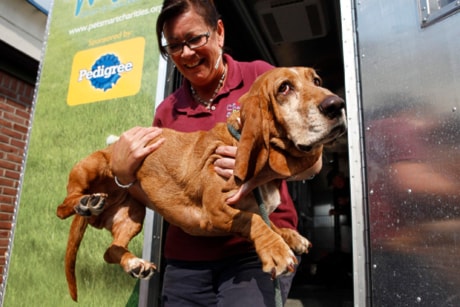WASHINGTON — It’s usually a sad story when dogs arrive at an animal shelter. But the mood is more like Christmas morning as staff at the Washington Animal Rescue League wait for the Rescue Waggin’ truck to open its doors.
The people and the animals have never met, but some greet like old friends. A basset shoots out to lick a face. Jodie Martin holds a small black puppy, one of the almost 40 dogs that she and the driver picked up that morning from two shelters in Ohio, and kisses it on the head before she hands it over.
“These are beautiful dogs,” said a staff member at the Washington, D.C., shelter.
The Rescue Waggin’ program of PetSmart Charities has moved more than 29,000 dogs since 2004 from communities with high euthanasia rates to shelters with high adoption rates.
Their four trucks transport dogs from 53 shelters in 24 states, including a new route that serves Mississippi, Louisiana, southern Tennessee and Arkansas.
The pups travel in style: Specially designed trucks have air conditioning, piped-in music and video cameras so the dogs can be monitored in transit.
The policy is not to transport animals more than 10 hours at a stretch, so the organization has just built a halfway kennel for overnight breaks to make longer trips a possibility.
When the dogs are led into their temporary home at the Washington Animal Rescue League, there’s a full service hospital, a behaviour department and a beautiful cageless shelter facility where a soothing fountain cascades over glass ceilings that let in natural light.
“We work on their physical, mental and social rehabilitation and transition them to new homes,” says the league’s director, Dr. Gary Weitzman.
If you live in a big city with a shelter like this one, it might be hard to understand how different the situation is in communities where the pups come from.
Mark Southwick says that when he started volunteering at the Parke-Vermillion County, Indiana, Humane Society in 2004, the euthanasia rate was 56 per cent, including many perfectly adoptable animals, because they simply did not have the resources to either keep them or find them homes.
“Our shelter is situated in a very rural setting — we are literally in the middle of a cornfield,” he says.
The shelter budget allows only enough paid staff to feed and clean. Volunteers like Southwick do all the adoption placement work. Volunteer efforts such as posting animals on Petfinder.com and transporting small groups of puppies to other shelters helped get the euthanasia rate down to 15-20 per cent, Southwick says. Now, with Rescue Waggin’, it’s under two per cent.
Moving animals in search of adoptive homes is not a new idea, but the scale of this program is unprecedented. Even a shelter like the Washington Animal Rescue League, which has long transported animals on its own, is enthusiastic about participating.
Weitzman says that it’s a big help not to have to bear all of the costs, and the Rescue Waggin’ trucks are state of the art.
When he was on a committee to come up with guidelines for animal transportation, he says, “we found that we couldn’t do better. They’re really doing it right.”
The program also does more than move animals around, with support services to help shelters improve the situation closer to home.
“If all we did was transport, that would not be the answer,” said Marlene Walsh, director of Rescue Waggin’ operator Humane Strategies.
Southwick’s shelter has received grants from PetSmart Charities for facilities improvement and training to prevent illness. Most important, they are now able to offer low-cost spay and neuter services one day per week to the community and shelter animals.
For the shelters, the effects go far beyond the visible ones.
“The thing that has changed so much is the more positive outlook,” Southwick says.
Now that they no longer euthanize so many animals, volunteering and donations are up and staff turnover is at an all-time low, with positive results for all the animals, whether they leave on the Rescue Waggin’ or not.
Says Southwick, “I see hope for these animals that I never saw before.”
